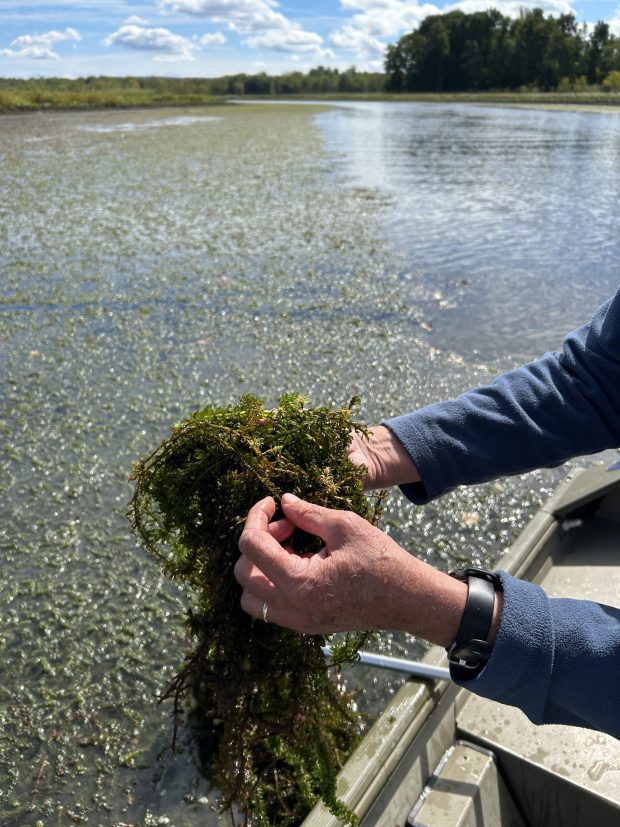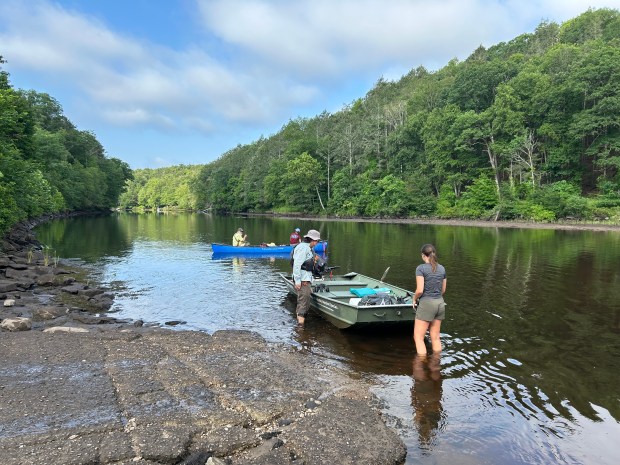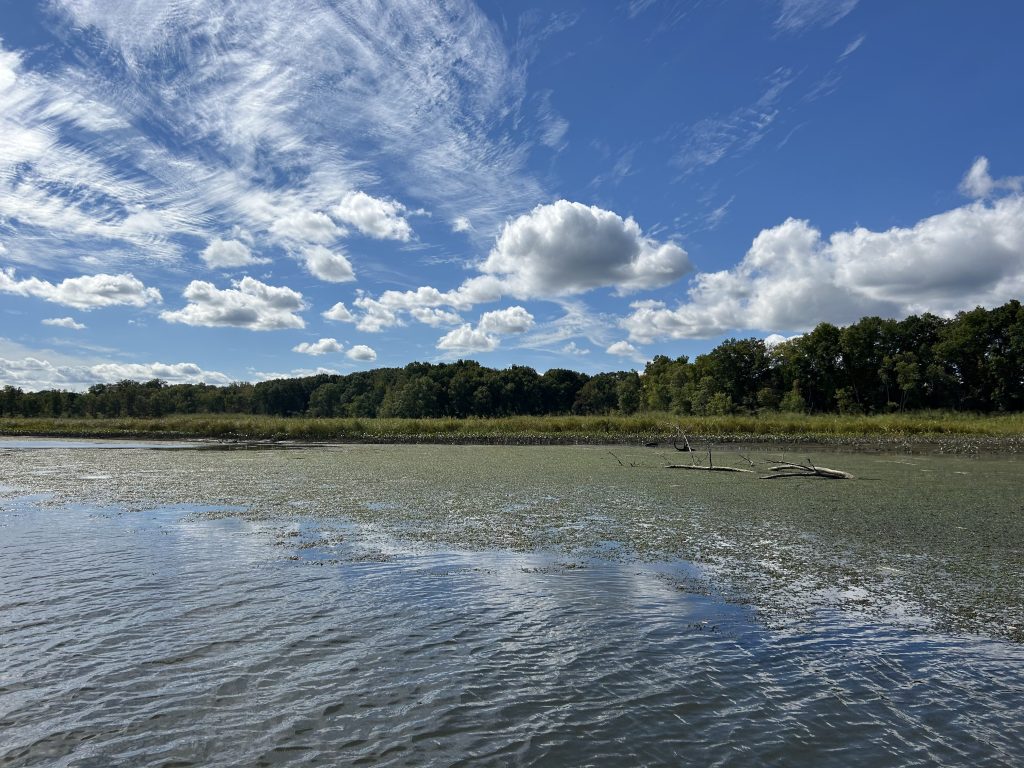Another summer has produced mixed results in the fight against hydrilla, the pernicious, aquatic weed choking the Connecticut River and threatening a half century of environmental progress that has made the river a $1 billion-plus annual contributor to the state economy.
On the positive side, herbicide treatments at locations selected among the river’s powerful tidal flows have proven effective and even suggest that the applications may inhibit the invasive weed’s astonishing, perennial reproduction.
After two years of herbicide application in formerly infested Wethersfield Cove, the town, which is running its own eradication program — decided it didn’t need a third.
But there also is grim news. Over just three years, the genetically unique and particularly aggressive strain of hydrilla first spotted in the Connecticut River in 2016 has jumped to 11 of the state’s fragile lakes and ponds, probably through fragments carried on the boats and trailers of fisherman and recreational boaters.
There was bad budget news too. With Connecticut and its river towns unable or unwilling to pay for all the cost of studying and testing to curb weed growth, the U.S. Army Corps of Engineers took the lead, with money to build on groundbreaking work by the state’s new Office of Aquatic Invasive Species, part of the Agricultural Experiment Station.
Based on a summer of successful trials in 2024, the Corps planned to expand its program of testing the effectiveness of a variety of herbicides to about 16 river locations over the summer of 2025. But Congress cut most of the funding and the White House impounded what remained, leaving only enough money to test the effect of herbicides at about a quarter of those spots.
 Greg Bugbee looks for turions. a resistant plant bud found in certain aquatic plants and can allow the plant to survive winter in the vegetative state (i.e., without setting seeds). (Edmund H. Mahony)
Greg Bugbee looks for turions. a resistant plant bud found in certain aquatic plants and can allow the plant to survive winter in the vegetative state (i.e., without setting seeds). (Edmund H. Mahony)
“No one wants this to happen,” Keith Hannon, Connecticut River project manager for the Army Corps said. “So no one was really planning for it. We just have to respond. We are going to do what we can with what we have. That’s the message for everyone to understand. We are still working.”
What the Corp is doing is testing a variety of herbicides in different river flow and tidal conditions in order to report on what combination of herbicides works best in what conditions. The report is intended for future use by the state, towns, combinations of towns or associations as a guide to control the weed, which can kill recreational activity — and real estate values — by growing into football field-sized mats that take over the entire water column.
Compounding the Corps’ financial problems was an intense, if brief, internet campaign that looked like an uninformed attempt to derail the hydrilla program by circulating inaccurate information about diquat, one of the herbicides the Corps is testing. The internet campaign circled the globe: People in South America reposted accusations that the U.S.government is “poisoning” the Connecticut River.
In reality, diquat has been in use as an herbicide for more than 40 years, with the approval of federal and state regulators. The state Department of Energy and Environmental Protection routinely approves its use by lake associations across the state. It is what Wethersfield used to cure its hydrilla problem. Homeowners have been buying diquat brand name garden products for decades to kill weeds.
 Staffers from DEEP and state Office of Aquatic Invasive Species prepare to look for endangered native plants along the Salmon River at Haddam Neck before approving an herbicide application to slow hydrilla growth.(Edmund H. Mahony)
Staffers from DEEP and state Office of Aquatic Invasive Species prepare to look for endangered native plants along the Salmon River at Haddam Neck before approving an herbicide application to slow hydrilla growth.(Edmund H. Mahony)
Owner Bob Petzold said Diquat made a remarkable difference with no adverse effects at Chester Boat Basin, where hydrilla was so thick it impeded the maneuverability of boats.
“It does a great job,” Petzold said. “In our basin there are a lot of turtles and fish and birds. There have been no negative effects at all. It’s actually a sought after area for people to fish, for bass and things like that. And we haven’t noticed any difference at all.”
The misinformation campaign caused the Army Corps to divert resources to a public relations campaign after, among other things, one of the corps’ hydrilla staff received a death threat.
While end-of-the-world posts about environmental poisoning circulated across the internet, scientists from around the country were studying what Connecticut is doing to control it.
“New” hydrilla was the subject of the Aquatic Plant Management Society meeting in Providence, in July. Greg Bugbee, the scientist at the office of aquatic invasive species whose work laid the groundwork for the Army Corps program, described hydrilla’s movement from the river to lakes and ponds.
A colleague of Bugbee’s was a principle speaker, as were members of the Army Corps’ Connecticut River team. U.S. Richard Blumenthal, who is trying from his seat on the Senate Armed Services Committee to add to the Corps budget, delivered the opening remarks.
“Hydrilla poses a tremendous risk to Connecticut and all of New England by threatening wetland ecosystems, public drinking water supplies and our tourism industry,” Blumenthal said.
Hydrilla has long been a troublesome weed , but mostly for its infamous propensity to clog ponds and block irivers in the South. That changed in 2016, when amateur botanists found what they considered an odd weed that looked like hydrilla growing in Keeney Cove in Glastonbury.
It was hydrilla, but DNA testing revealed it to be a genetically unique strain not known elsewhere. In the years since, it spread explosively to cover more than 1,000 acres of river and tributaries from Essex to Springfield. Scientists believe what is now referred to in scientific literature as Connecticut River Hydrilla, originated somewhere in Eurasia and entered the U.S. as a decorative aquarium plant.
It is believed to have got into the river when someone emptied a fish tank.
Scientists who have studied Connecticut River hydrilla say it has the ability to adapt and in some cases control its environment in self-serving ways that cripples the native competition..
It blocks sunlight from penetrating beneath the water’s surface, killing plants like eel grass that make the river an important spawning ground for fish like menhaden, the food source for striped bass, bluefish, mackerel, flounder, tuna, drums, and sharks.
Hydrilla can raise water temperature and reduce water flow, causing sedimentation and turning shallow tributaries and adjacent lowlands into acres of mosquito breeding ground.
And it has developed an ability to tap an alternate source of carbon, an element essential to photosynthesis and plant growth, when water chemistry fluctuates and decreases carbon dioxide in the water.
While native plants shut down, waiting for carbon dioxide levels to return, hydrilla keeps growing, expanding its advantage over the natives by utilizing another source of carbon, the bicarbonate produced by the slow, geologic weathering of rocks, according to Jeremiah Foley, a scientist with the state Office of Aquatic Invasive Species
Hydrilla can grow in fresh and brackish water in depths of 25 feet. With multiple branches that can grow three inches a day, a plant can double its biomass every two weeks. When plants reach the surface, they branch out, lie flat and shut off the light necessary for photosynthesis for everything in the water column below.
If a piece of a branch breaks off, it starts a new plant wherever it settles.
Mats of hydrilla lying on the surface at the height of summer make it difficult or even impossible to swim, paddle, run a boat or even sink a fish hook.
Invasive plant scientists have become familiar sights to homeowners and boaters along the lower river over the last three years, injecting dye into the river through tubes to plot currents, injecting herbicides once the flows are charted and returning to measure progress.
The results have been remarkable so far based on a half dozen or so test sites between Glastonbury and Chester.
Selden Cove, tucked between big granite bluffs in Hadlyme, is again a magnet for anglers, a clear pond over a sandy bottom from which a wide creek runs south through sunken meadows of wild rice and drowned oaks to join the river at the bottom of Selden Neck. Two years ago, the cove and creek were impenetrable.
Eradication results are less striking on fast-flowing, straight stretches, like the one between Portland and Middletown, where the river pours by unobstructed.
Still other spots present challenges, such as the Mattabesset River, a mile west of the point where it meets the Connecticut River in Middletown. Bugbee took his survey boat up the Mattabesset last week and found acres of hydrilla constricting the channel.
The plants were thick with turions, the resilient buds that will break off and float south in the coming weeks, forming new plants wherever they land.
The hydrilla plant has been found in Amos Lake, Preston; Bashan Lake, East Haddam; Congamond Lakes, Southwick; Connecticut River, all coves and tributaries; East Twin Lake, Salisbury; Gardner Lake, Salem, Montville and Bozrah; Middle Bolton Lake, Vernon; Pachaug Pond, Griswold; Pameacha Pond, Middletown; Pocotopaug Lake; East Hampton; Holbrook Pond, Hebron; City Lake, Wilton; South Norwalk Electric and Water; Coventry Lake, Coventry Held Pond; Weston Lake Lillinonah, Brookfield, Bridgewater, Newtown, New Milford, Roxbury, and Southbury, Housatonic River and Shepaug river impoundment; Laurel Reservoir, Stamford, New Canaan; Aquarion Meckauer Park Pond, Bethel; Mystic Seaport Pond, Mystic Masons Island; Mystic Silvermine River and surrounding waterbodies, Popes Pond, Wilton: South Norwalk Electric and Water, records show.
Originally Published: October 6, 2025 at 5:30 AM EDT
